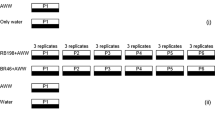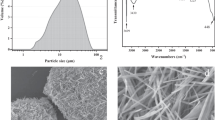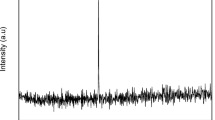Abstract
The effect of pH on the bleeding of FD&C yellow No. 5 aluminum lake and FD&C red No. 40 aluminum lake was investigated. The pH–bleeding profiles corresponded to the pH–solubility profile of aluminum hydroxide. The similarity of the bleeding profiles of both lake dyes and the pH–solubility profile of aluminum hydroxide indicates that pH related bleeding, other than that occurring by competition with anions, is a result of dissolution of the aluminum hydroxide substrate. This dissolution is related to the properties of the substrate rather than to the structure of adsorbed dye.
Similar content being viewed by others
REFERENCES
K. McLaren. The Colour Science of Dyes and Pigments, Hilger, Bristol, 1983, pp. 1–21.
D. M. Marmion. Handbook of U.S. Colorants for Foods, Drugs, and Cosmetics, Wiley-Interscience, New York, 1973, pp. 38–73.
R. C. Rowe. Materials used in the film coating of oral dosage forms. In A. T. Florence (ed.), Materials Used in Pharmaceutical Formulations, Blackwell, Oxford, 1984, pp. 1–36.
R. K. Mishra, G. L. Mundhara, and G. S. Tiwari. Sorption-desorption studies of anionic dyes on alumina pretreated with acid. J. Colloid Interface Sci. 129:41–52 (1989).
Y. Kubo, M. Shirai, and Y. Makita. Dye elution from aluminum lakes of synthetic food color (I). Tartrazine lakes from commercial origins. Shikizai Kyokaishi 59:155–161 (1986).
Y. Kubo, M. Shirai, and T. Iijima. Dye elution from aluminum lakes of synthetic food colors (VII). Lakes produced by one step method. Shikizai Kyokaishi 60:83–93 (1987).
J. D. Hem and C. E. Roberson. Form and stability of aluminum hydroxide complexes in dilute solution. Geological Survey Water Supply Paper 1827-A. United States Government Printing Office, Washington, DC, 1967.
G. A. Parks. Free energies of formation and aqueous solubilities of aluminum hydroxides and oxide hydroxides at 25°C. Am. Mineral. 57:1163–1169 (1972).
J. D. Hem. Geochemistry and aqueous chemistry of aluminum. Kidney Int. 29:53–57 (1989).
A. Packter and H. S. Dhillon. The heterogeneous reaction of gibbsite powder with aqueous inorganic acid solutions; Kinetics and mechanisms. J. Chem Soc. (A) 2588–2592 (1969).
C. E. Roberson and J. D. Hem. Solubility of aluminum in the presence of hydroxide, fluoride and sulfate. Geological Survey Water Supply Paper 1927-C; United States Government Printing Office, Washington, DC, 1969.
Author information
Authors and Affiliations
Rights and permissions
About this article
Cite this article
Desai, A., Peck, G.E., Lovell, J.E. et al. The Effect of Aluminum Hydroxide Dissolution on the Bleeding of Aluminum Lake Dyes. Pharm Res 10, 1458–1460 (1993). https://doi.org/10.1023/A:1018971208521
Issue Date:
DOI: https://doi.org/10.1023/A:1018971208521




